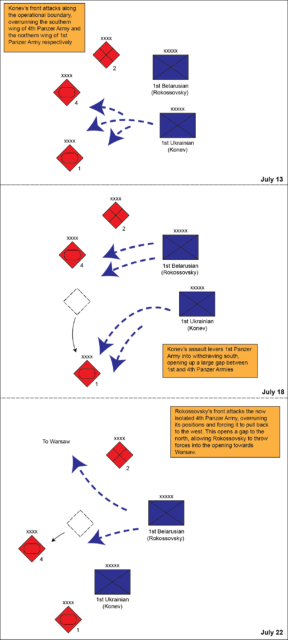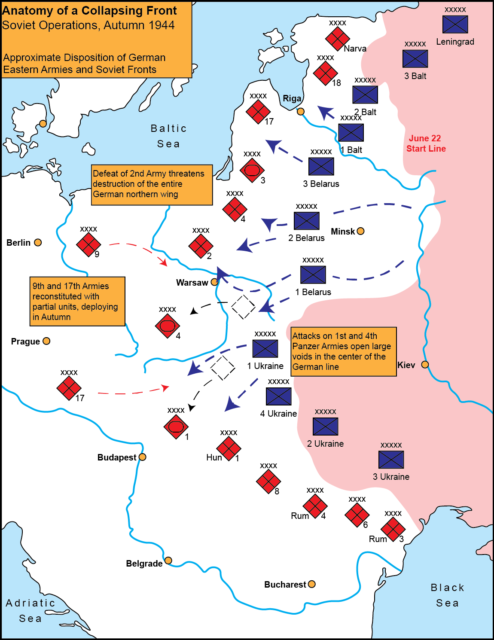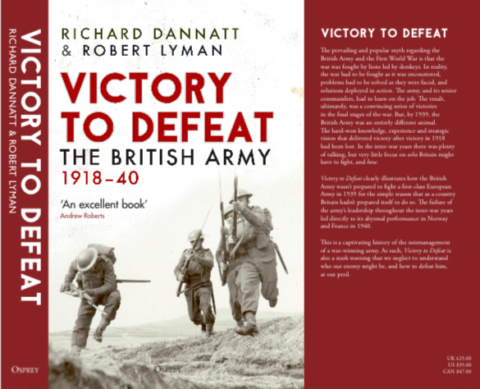The Tank Museum
Published 15 Sept 2023The first ever use of the tank in battle happened during the Battle of the Somme in 1916. In this video we look inside a unique survivor – the last British Mark I Heavy Tank in existence and examine the first tank action at Flers, an event that changed the face of warfare.
(more…)
January 6, 2024
Inside Mark I: The First Fighting Tank
December 29, 2023
The Soviet follow-on operation after Bagration
Big Serge discusses the state of the Germans on the Eastern Front at the end of the massive Soviet attacks that collapsed Army Group Centre in 1944:
But now, as Bagration began to run out of momentum, the Soviets really did put Model’s army group in the crosshairs with an enormous follow up offensive — the second phase of their summer blockbuster. Model’s army group consisted of two Panzer Armies (the 4th and 1st), and an allied Hungarian force guarding the southern flank. On paper, a pair of Panzer Armies was a formidable force, but like all German units at this stage in the war they were understrength, and by this point they were already bleeding strength as panzer divisions were scrambled north to try and slow down Operation Bagration.
Arrayed against Model’s force were two Soviet Fronts (the equivalent of an Army Group) under a pair of the Red Army’s best operators. The lead off assault came on July 13, with Marshal Ivan Konev’s 1st Ukrainian Front forcing positions in the interstitial zone between Model’s two Panzer Armies. Konev’s intention was to split the two armies apart, force a penetration between them, and then curl into the rear to encircle one, or if possible both of them. Therefore, Konev’s initial assault was highly concentrated, with as much as 70 percent of his artillery and 90 percent of his armor assembled in a few narrow sectors selected for breaching.
With this level of force concentration by the attackers, there was really little that the Germans could do. Nevertheless, a somewhat lethargic and stiff German response helped make the disaster even worse. 4th Panzer Army headquarters initially believed Konev’s opening assault to be only a local attack – later defensively arguing that “there were as yet no signs of the attack being extended to other sections of the front” — and so attempted to respond with local counterattacks by its own reserves. As a result, by the second day of the Soviet offensive the Panzer Army had already committed all of its organic reserves while failing to withdraw from defensive positions that were already compromised. By the time they realized that Konev was launching a serious offensive operation, it was too late. Konev had already bashed into critical seams in the German front, turning his forces into a giant splitting wedge, in place to pry the whole front open.
[…]
What the Soviets had achieved with their enormous assaults on Army Group North Ukraine was remarkable. By precisely targeting the seams in the German formations, the initial attacks had pried open the German position like a clam, forcing the two panzer armies to retreat in opposite directions — the 1st pulling back to the south towards Hungary, and the 4th withdrawing westward towards Krakow. These diverging withdrawals opened enormous voids in the German line — the official German history of the war simply refers to this sequence of events as “the loss of a continuous front”. In a war where the enemy wielded vast mechanized forces, such gaps were fatal.
Rokossovsky and Konev had essentially overrun an entire German army group — and the best equipped group in the east, at that — in the space of about ten days, wedging the German line open and creating vast voids to drive into. Most importantly, Rokossovsky now faced one of the more tantalizing opportunities of the entire war. A great space now beckoned him to drive north towards Warsaw, and in his path was only the tired remnant of German second army — a force with no armor whatsoever, caught completely out of position.
Any wargamer could look at the map as Rokossovsky saw it and see that the opportunity to win a seminal, world-historical victory was now within reach. A sharp drive on Warsaw would put him in position to not only capture the city (a major transportation, administrative, and supply base), but also smash through the threadbare German 2nd Army and drive to the Baltic Coast. If he could achieve this, fully half of the German eastern forces would be encircled — the entirety of Army Group North (still fighting on the Baltic Coast) and everything that remained of Army Group Center. Rokossovksy now saw little standing between his powerful Front and one of the greatest encirclements — perhaps the greatest — of all time. No less than six German armies were sitting, naked and vulnerable, on the proverbial silver platter.
The Eastern Front was on the verge of total collapse. If Rokossovsky could bash through Warsaw (a seemingly simple proposition, given the enormous overmatch that he enjoyed over German 2nd Army), he would wipe out half the German eastern army and face no meaningful German forces between him and Berlin.
December 28, 2023
War-winning expertise of 1918, completely forgotten by 1939
Dr. Robert Lyman writes about the shocking contrasts between the British Army (including the Canadian and Australian Corps) during the Hundred Days campaign of 1918 and the British Expeditionary Force that was driven from the continent at Dunkirk:
There was a fleeting moment during the One Hundred Days battles that ended the First World War in France in which successful all-arms manoeuvre by the British and Commonwealth armies, able to overturn the deadlock of previous years of trench stalemate, was glimpsed. But the moment, for the British Army at least, was not understood for what it was. With hindsight we can see that it was the birth of modern warfare, in which armour, infantry, artillery and air power are welded together able successfully to fight and win a campaign against a similarly-equipped enemy. Unfortunately in the intervening two decades the British Army simply forgot how to fight a peer adversary in intensive combat. It did not recognise 1918 for what it was; a defining moment in the development of warfare that needed capturing and translating into a doctrine on which the future of the British Army could be built. The tragedy of the inter-war years therefore was that much of what had been learned at such high cost in blood and treasure between 1914 and 1918 was simply forgotten. It provides a warning for our modern Army that once it goes, the ability to fight intensively at campaign level is incredibly hard to recover. The book that General Lord Dannatt and I have written traces the catastrophic loss of fighting knowledge after the end of the war, and explains the reasons for it. Knowledge so expensively learned vanished very quickly as the Army quickly adjusted back to its pre-war raison d’etre: imperial policing. Unsurprisingly, it was what many military men wanted: a return to the certainties of 1914. It was certainly what the government wanted: no more wartime extravagance of taxpayer’s scarce resources. The Great War was seen by nearly everyone to be a never-to-be-repeated aberration.
The British and Commonwealth armies were dramatically successful in 1918 and defeated the German Armies on the battlefield. Far from the “stab in the back” myth assiduously by the Nazis and others, the Allies fatally stabbed the German Army in the chest in 1918. The memoirs of those who experienced action are helpful in demonstrating just how far the British and Commonwealth armies had moved since the black days of 1 July 1916. The 27-year old Second Lieutenant Duff Cooper, of the 3rd Battalion The Grenadier Guards, waited with the men of 10 platoon at Saulty on the Somme for the opening phase of the advance to the much-vaunted Hindenburg Line. His diaries show that his experience was as far distant from those of the Somme in 1916 as night is from day. There is no sense in Cooper’s diaries that either he or his men felt anything but equal to the task. They were expecting a hard fight, but not a slaughter. Why? Because they had confidence in the training, their tactics of forward infiltration, their platoon weapons and a palpable sense that the army was operating as one. They were confident that their enemy could be beaten.
[…]
It would take the next war for dynamic warfare to be fully developed. It would be mastered in the first place by the losers in 1918 – the German Army. The moment the war ended the ideas and approaches that had been developed at great expense were discarded as irrelevant to the peace. They weren’t written down to be used as the basis for training the post-war army. Flanders was seen as a horrific aberration in the history of warfare, which no-right thinking individual would ever attempt to repeat. Combined with a sudden raft of new operational commitments – in the remnants of the Ottoman Empire, Russia and Ireland – the British Army quickly reverted to its pre-1914 role as imperial policemen. No attempt was made to capture the lessons of the First World War until 1932 and where warfighting was considered it tended to be about the role of the tank on the future battlefield. This debate took place in the public arena by advocates writing newspaper articles to advance their arguments. These ideas were half-heartedly taken up by the Army in the later half of the 1920s but quietly dropped in the early 1930s. The debates about the tank and the nature of future war were bizarrely not regarded as existential to the Army and they were left to die away on the periphery of military life.
The 1920s and 1903s were a low point in national considerations about the purpose of the British Army. The British Army quickly forgot what it had so painfully learnt and it was this, more than anything else, that led to a failure to appreciate what the Wehrmacht was doing in France in 1940 and North Africa in 1941-42.
December 19, 2023
Christmas Message from the Museum – MERRY TANKMAS 2023
Ontario Regiment Museum
Published Dec 17, 2023Merry Christmas from the volunteers and staff of the Ontario Regiment RCAC Museum and our friends at World of Tanks. Please enjoy this festive message and get a look into Santa’s Tank Workshop!
This segment originally aired in the TANKMAS 2023 – LIVE Stream on 8 December 2023. Hosted by The Tank Museum (Bovington), and sponsored by our friends at World of Tanks.
https://worldoftanks.com/en/news/live…Full video and stream can be found on The Tank Museum YouTube channel here:
https://www.youtube.com/live/_5cMsW5Z…Meet our hosts from World of Tanks and Wargaming.net:
Nicholas “The Chieftain” Moran and Cmdr_AFMeet our Executive Director: Jeremy N Blowers AKA Tank_Museum_Guy
Wishing you and yours a Very Merry Christmas, and a safe and Happy Holiday season.
PLAY NOW at www.worldoftanks.com
FREE to play and build your own “Tank Museum” garage.Thank you to Wargaming.net for the video production and sponsorship of this museum centered Christmas streaming event.
December 18, 2023
Battle Taxis | Evolution of the Armoured Personnel Carrier
The Tank Museum
Published 8 Sept 2023Tanks and infantry need to operate together. Tanks provide firepower and protection, the infantry support and protect the tanks. In this video, we look at that vital component of the equation, the Armoured Personnel Carrier and its transition into the modern Infantry Fighting Vehicle.
(more…)
December 7, 2023
Carl Gustaf: Recoilless Rifle | Anti-Tank Chats
The Tank Museum
Published 25 Aug 2023From The Falklands to Ukraine; the Carl Gustaf recoilless rifle was introduced in 1948 and is still used by armies around the world today.
(more…)
December 5, 2023
See Inside Sherman Firefly | Tank Chats Reloaded
The Tank Museum
Published 1 Sept 2023Inspired innovation or a bit of a lash-up? In this video we look inside the legendary Sherman Firefly, the British Army’s Tiger killer. We also hear from a Firefly veteran, Ken Dowding, ex-14th/20th Hussars.
(more…)
November 28, 2023
Light Tank Mk IV | Tank Chats #173 | The Tank Museum
The Tank Museum
Published 18 Aug 2023Weighing in at five tons, machine gun armed and with a two-man crew, the Tank, Light, Mk IV was one of a series produced for the British Army by Vickers before World War II, seeing service on the NW Frontier of India. Recently restored, the Mk IV is the oldest running tank in our collection.
(more…)
November 21, 2023
Centaur | Tank Chats #172 | The Tank Museum
The Tank Museum
Published 28 Jul 2023Join David Willey as he tells the complex story of how the Centaur and its sister vehicles were developed when the need for a new cruiser tank emerged.
(more…)
November 18, 2023
World War Two’s most common tank
Lindybeige
Published 2 Aug 2023What click-bait title should I have used for this? “The tank that gave the Germans nightmares”? “The Commonest Communist tank?” “The tank of the teeming red hordes”? As I describe here, they made ever-so many of this type of tank, and that fact alone makes it an important tank.
(more…)
November 14, 2023
Inside T-72: A Commander’s Perspective | Tank Chats Reloaded
The Tank Museum
Published 21 Jul 2023A fast tank with a low profile and a big gun, the T-72 is a classic Soviet designed Main Battle Tank, in use all over the world. In this video, we talk to Dag Patchett, a former T-72 commander and get his impressions of a tank built in the Cold War era but still very much in service.
(more…)
November 7, 2023
Swiss Tankbuchse 41 Semi-automatic Antitank Rifle
Forgotten Weapons
Published 29 Oct 2018Originally developed for use in light tanks purchased from Czechoslovakia, the Tankbuchse 41 was a 24x139mm semi-automatic rifle designed by Adolph Furrer of the Waffenfabrik Bern factory. Furrer was also responsible for the LMG-25 and MP41/44 used by the Swiss, and with the TB-41 he once again used the operating system he was most familiar with: a short recoil toggle-locked action. The gun was ready and adopted in 1941, and a total of 3,581 were produced, used in light tanks, lake patrol boats, fortifications, and on wheeled carriages by the infantry.
High explosive and armor piercing projectiles were made, both weighing 3475 grains (225g) and with muzzle velocities between 2800 and 2950 fps (860-900 fps). The armor piercing round could perforate 30cm of perpendicular armor plate at 500m — more than most other contemporary antitank rifles. Designed specifically for rapid fire, the gun fed from six-round magazines, and automatically ejected the magazine when the last round was chambered, so that the crew could reload it without having to run the crank handle. The guns never saw combat use, and by the end of World War Two were being pulled back out of inventory and relegated primarily to fortress use.
(more…)
November 6, 2023
The Army Door Knocker | Pak 35/36 | Anti-Tank Chats
The Tank Museum
Published 14 Jul 2023In this video, we look at the Pak 35/36, the German Army’s first anti-tank gun. Obsolete by 1941, it picked up the nickname Heeresanklopfgerat – the army door knocker – after its inability to penetrate tank armour. In spite of this, it carried on in service until 1945. Chris Copson talks you through the gun and its history.
(more…)
November 3, 2023
Understanding Combined Arms Warfare
Army University Press
Published 24 Mar 2023Designed to support the U.S. Army Captains Career Course, “Understanding Combined Arms Warfare” defines and outlines the important aspects of modern combined arms operations. This is not a complete history of combined arms warfare. It is intended to highlight the most important aspects of the subject.
The beginning of the documentary establishes a common understanding of combined arms warfare by discussing doctrinal and equipment developments in World War I. The second part compares the development of French and German Army mechanization during the interwar period and describes how each country fared during the Battle of France in 1940. The film concludes by showing how the United States applied combined arms operations in the European Theater in World War II.
(more…)
October 28, 2023
Prototype Winchester WW1 .50 Cal Antitank Rifle
Forgotten Weapons
Published 5 Jul 2017With the advent of the tank in World War One, antitank rifles became a priority for many countries, to provide infantry with some weapon to counter the new armored threat. The best known example of these (and the only one to see significant production before the end of WWI) was the German Tankgewehr, any captured Tankgewehrs would form the basis for the US development of the .50 BMG cartridge.
This experimental Winchester rifle, made in late 1918, was part of that development. It is the only known surviving example of its type, and suffered a catastrophic failure during testing, as the receiver is cracked completely in half. The mechanism, however, is quite interesting. It uses a 1911-styled pistol grip as the bolt handle (similar to the Czech SS41 antitank rifle that would come decades later). It was fitted with a relatively large detachable box magazine and a mounting point for a telescopic sight.
(more…)






